NEW YORK CITY-Single-family homes weren’t the only housing type severely impacted by the economic downturn, new research shows. According to a new study from Citizens Housing & Planning Council, over-mortgaged and foreclosed multifamily buildings increase the risk of deterioration of nearby buildings and raise costs for private owners and the city in the form of additional Emergency Repair Program expenditures.
The study, commissioned and funded by Enterprise Community Partners, “The Impact of Multifamily Foreclosures and Over-Mortgaging in Neighborhoods in New York City” examines more than 1,100 multifamily buildings across Brooklyn, Bronx, Manhattan, and Queens. The study, according to Enterprise, highlights the need to monitor multifamily housing stock and coordinate public and private sector intervention so that the stock may be improved, returned to responsible owners and preserved for another generation of tenants.
“These buildings are in those neighborhoods, potentially threatening billions of dollars of public investment,” Shola Olatoye, deputy director and director of relationship management at Enterprise, tells GlobeSt.com. “That’s the real issue. It is imperative for both the public sector and others to realize they are dealing with the impact of multifamily buildings are not just on those buildings, but as the report rightly points out, the already invested public dollars that are in those neighborhoods.”
The findings—based on methodology applied for single-family home foreclosures—indicated that the average number of class C housing code violations—the most serious—increased 123.7% between 2008 and 2010 in buildings located within 250 feet of an over-mortgaged building. Buildings outside of a 250 feet radius only increased their average class C housing code violations by 6.3%, according to the study.
Nearby apartment buildings are also susceptible to these impacts. For buildings within a 500-foot radius of an over-mortgaged building, the average percentage increase in emergency repair program liens per building was 198%. However for buildings outside of the 500-foot radius, the average percentage decrease in ERP charges was 39%.
The study found that buildings within a 500-foot radius had $1,892,142 more in ERP charges in 2010 than they would have had if they were not near an over-mortgaged or foreclosed property.
Harold Shultz, senior fellow at the CHPC, tells GlobeSt.com that he hopes the study will raise awareness about the distressed multifamily market. “We’ve seen a number of studies showing that distressed single-family homes have a negative market impact on their surrounding neighborhoods,” he says. “We were unable to find any other study that focuses on the multifamily distressed buildings and its surrounding buildings. They are both phenomena of the same housing bubble.”
The data for the analysis was provided by Local Initiatives Support Corporation and the Urban Homesteading Assistance Board, via a grant from the Charles H. Revson Foundation, as well as the University Neighborhood Housing Program’s Building Indicator Project database. Additional data was provided by the New York City Department of Housing Preservation and Development.
To view the full report, click here.
Want to continue reading?
Become a Free ALM Digital Reader.
Once you are an ALM Digital Member, you’ll receive:
- Breaking commercial real estate news and analysis, on-site and via our newsletters and custom alerts
- Educational webcasts, white papers, and ebooks from industry thought leaders
- Critical coverage of the property casualty insurance and financial advisory markets on our other ALM sites, PropertyCasualty360 and ThinkAdvisor
Already have an account? Sign In Now
*May exclude premium content© 2024 ALM Global, LLC, All Rights Reserved. Request academic re-use from www.copyright.com. All other uses, submit a request to [email protected]. For more information visit Asset & Logo Licensing.








